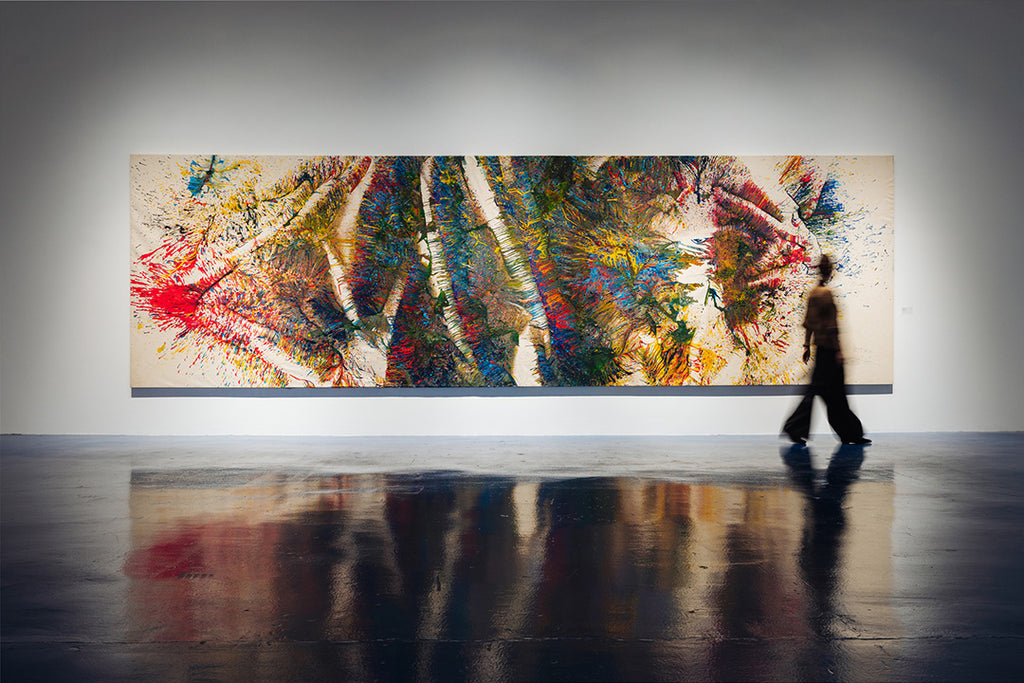ARTICLES
表達者金山明的重要地點——位於大阪的妙法寺 相關人員專訪(續篇)
GUTAI STILL ALIVE 2015 vol.1
28/35

本系列企劃為您推出關於具體美術協會的書籍《GUTAI STILL ALIVE 2015 vol.1》的數字檔案。第28期關注具體美術協會成員、1965年退出該會的金山明。我們在金山的重要活動基地、位於大阪的妙法寺,請伊藤加奈子女士講述了她所了解的金山與公私兩方面的終身伴侶藝術家田中敦子的關係,以及作為藝術家的為人和創作活動。
拜訪伊藤加奈子女士
金山明和田中墩子作為活動基地的大阪妙法寺 藝術家共同走過旅程的起點和終點(續篇)
位於大阪的妙法寺是金山明和田中敦子的重要活動基地,這裡不僅有美術作品,還留下了金山明的另一份足跡。妙法寺的伊藤加奈子女士在帶領我們參觀時指著寺廟各處的書法字跡不停地介紹說「這也是金山先生寫的」。 從刻在石柱上的文字到塔型木牌的文字,再到記錄寺廟的文章,到處都留有金山的手跡。這是由於金山明的弟弟曾擔任妙法寺的住持,而寺廟有許多工作需要用毛筆和墨汁書寫,因此書法嫻熟的金山明在這方面提供了不少幫助。這些書寫工作已由伊藤加奈子女士從金山明手中繼承過來。
伊藤:金山老師住在寺廟院內另一處房屋裡的時候,我曾和附近的孩子們一起學過畫畫。但被金山老師指出「你沒有天賦啊」(笑)。他說得很直白。儘管畫畫如此,但我也學過書法。在書法方面,寺廟舉辦法事時所需的文字以及墓地的塔型木牌等文字等,都曾由金山老師擔任書寫。從我父親當住持的時候開始就一直如此。我總是在旁邊看著。我雖然不太喜歡畫畫,但很喜歡寫字。因此,現在寺院的書寫工作全部由我負責。金山老師的字寫得非常漂亮。據說是認真地跟書法老師學過的。但是,他年輕時曾被一位書法老師說過「你的字沒有品味」。金山老師說他聽了此話後就決定發奮學習寫字。他本來就很擅長寫字,但被這麼說了之後就更加努力習字,據說最後書法老師也不得不給他寫下了「脫帽認輸」這四個字。他不僅在書法方面如此,對於任何事情都做得認真徹底。他曾熱衷於學習英語等各種事物,總是攜帶著英語會話課本,並經常告訴我正在學習什麼。我小時候曾找他商量過暑假理科自由選題作業該怎麼做,他拿來天文望遠鏡說可以觀測太陽黑子,並教我怎麼做。於是我就用望遠鏡進行了觀測。
伊藤加奈子女士曾經最近距離地見證了伯伯夫婦金山明和田中敦子的活動。即使在金山夫婦後來搬到奈良縣明日香村之後,她也與金山明之間仍然保持著親密的伯伯與姪女的關係。此外,她與金山明的親弟弟、自己的父親伊藤先生也關係良好。
伊藤:金山老師還在世的時候發生的一些事情感覺就像是剛剛發生過一樣,每年盂蘭盆節之前寺院都要寫很多塔型木牌,所以金山老師會住一宿幫忙。因為在寺廟里寫到了深夜,當然第二天一大早就睡了。這時擔任住持的我父親興高采烈地拿著尺子過來,猛然敲打在睡夢中的金山老師身上,然後兩個人就在寺廟里追逐嬉戲起來。兩位爺爺一般歲數的人跑來跑去,實在是非常有趣。金山老師對我父親非常疼愛,兩人關係特別好,感覺總是在一起。即使他前往海外,也一定會在動身前來到我家,說一聲「拜託了」,然後才離開。搬到奈良的明日香村之後,金山老師也因為要在大阪教授繪畫,或者有各種事情要處理,所以至少每周都會來一次我家。每次他來大阪時總會順道來我家,然後從我家去別的什麼地方。
在「具體」藝術家中,金山明有著異質的理性形象,但從伊藤女士的介紹當中,我們似乎看到了他非常幽默並比較顧家的一面。在上一期的專訪當中,伊藤女士曾介紹說,儘管金山明本身是一位藝術家,但他行動時總是首先考慮到如何為田中敦子創造繪畫環境。然而,伊藤女士仍然看到了他作為藝術家的一面。
伊藤:金山老師是一個非常講究和執著的人,總是認真地把各種事情都寫在記事本上。我聽說他並沒有怎麼進行自己的創作,而是為了田中老師而停止了幾乎所有的創作活動,但偶爾也會向我透露一些正在考慮的計劃。比如在製作音樂波形的作品時,他說即使同樣做成波形,但還是被稱為名曲的音樂波形特別漂亮。在創作天體作品時,他說因為想做天體題材,所以去見了一位非常了不起的天文台台長。總之,他經常會告訴我類似這樣的事情。他時常都有一些創意和想法,總在說似乎能做這樣或那樣的有趣事情。他是一位傾注了許多心血的老師,所以我希望他能青史留名。金山老師給我講了許多他和我爸爸小時候做過這個做過那個的故事,內容都特別有意思,而且他頭腦清晰、聰明絕頂。在天文學也有仰慕金山老師的人,在美術方面好像更是有大批弟子與合作者。他有一種會令人著迷的魅力。他年輕的時候,左鄰右舍有不少人因為看中他的人品而提供了各種各樣的幫助。前些時候,我看了一段老影像,他在摩托車上安裝了煙霧彈,然後驅車飛馳而過。那是在我們家門前的道路,雖然影像內容僅此而已,但卻是從高處拍攝的。飛車的人和拍攝的人,大家都聽老師的話,為他做事。有一個作品是用機器繪制的,其家族墓地在我們寺院裡的一個人曾經說,那個機器是他製造的。金山老師可能也具有一種能讓周圍的人都成為合作者的力量。
伊藤女士回憶說,隨著田中敦子的製作環境穩定下來,曾一直追求尖端表達方式的金山明到了晚年以後,終於開始考慮自己也是時候要多創作一些作品了。伊藤女士說,她曾聽金山講述過一些新作品的創意,也近距離地目睹了他的生活方式。她指出如果不是因為遭遇事故而被迫中斷的話,金山明本應該留下更多的作品。
伊藤:2007年在豐田市美術館舉行的金山老師的展覽會是他十分期盼的一次展會,沒想到最終變成了他的回顧展,這實在太遺憾了。展覽會舉辦得相當好,我去參觀的時候深感惋惜地想,如果老師還健在的話,該有多好啊。
展覽會的兩年前,即2005年,金山夫婦外出用餐時乘坐的汽車遭遇了交通事故。同年年末田中敦子去世,第二年金山明也隨之離世。此事發生在金山展覽會在豐田市美術館展舉辦的前一年。一直到最後,住院和入住看護設施的所有手續和繁雜事務,都是由伊藤女士照料辦理的。金山明之所以在三重縣度過了人生的最後一段時光,是為了在豐田市美術館舉辦展覽會期間能方便他前往會場,因此才安排他住進了離豐田市較近的三重縣四日市市的設施。但是,交通事故導致金山體力衰弱,並罹患了肺癌,最終與世長辭。
位於大阪的妙法寺也是金山明和田中敦子作為藝術家從事創作活動的依託之地,由於親人和親屬之間的關聯,這座寺院曾經充滿溫暖地關注和守護著他們兩人的創作活動。而且兩人的牌位至今也依然安放在妙法寺的「報恩堂」中。
(刊登於《畫廊月刊》2014年9月號)
文中提到的資訊是文章發佈當初的情況,某些部分也許已與現狀有所不同。



